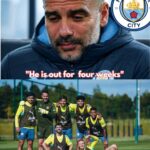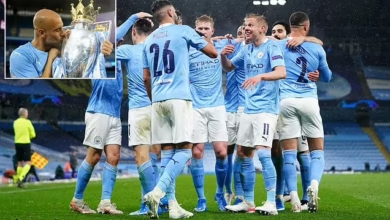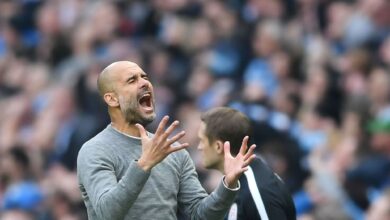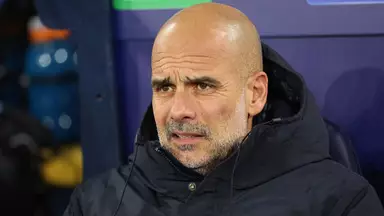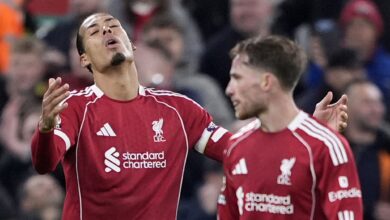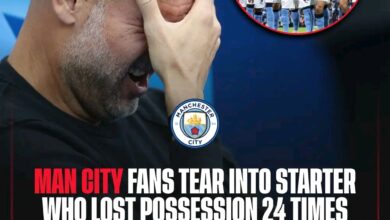Manchester City’s Injury Crisis: A Season-Defining Challenge Ahead of FA Cup Final
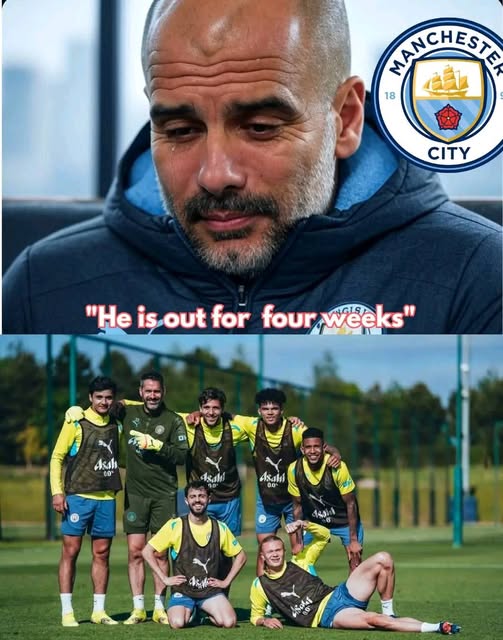
As Manchester City prepares for one of the most significant matches of their season—the FA Cup Final against Crystal Palace on Saturday—the club finds itself grappling with a mounting injury crisis that threatens to derail their ambitions across multiple competitions. The latest confirmation from renowned transfer specialist Fabrizio Romano has sent shockwaves through the City faithful, as yet another key player has been ruled out of the Wembley showpiece, adding to an already extensive list of absentees that includes some of the squad’s most influential figures.
The Unfolding Crisis
The injury situation at Manchester City has reached critical proportions, with manager Pep Guardiola facing perhaps his most challenging squad management test since arriving at the Etihad Stadium. What began as isolated incidents has snowballed into a comprehensive crisis that is forcing the Spanish tactician to completely reimagine his tactical approach and squad rotation strategies. The timing could hardly be worse, with the club still competing on multiple fronts and crucial fixtures arriving in rapid succession.
The psychological impact of these injuries extends far beyond the immediate tactical concerns. For a club that has built its recent success on the foundation of squad depth and tactical flexibility, the current situation represents an unprecedented challenge. Players who might typically be considered squad players are now being thrust into starring roles, while young academy prospects are being fast-tracked into first-team consideration far earlier than originally planned.
Rodri: The Irreplaceable Anchor
At the heart of Manchester City’s injury woes lies the devastating loss of Rodri, the Spanish midfielder whose influence on the team’s success cannot be overstated. The ACL injury sustained in September has not only ended his season but has created a void in City’s midfield that has proven impossible to fill adequately. Rodri’s unique combination of defensive awareness, passing range, and tactical intelligence made him the fulcrum around which Guardiola’s entire system revolved.
The statistics surrounding Rodri’s importance to Manchester City make for sobering reading. Prior to his injury, City had lost just one Premier League match in their previous 74 games when the Spanish international was in the starting lineup. His absence has coincided with a noticeable drop in the team’s ability to control games from midfield, with opponents finding it significantly easier to press City’s build-up play and create transition opportunities.
The ripple effects of Rodri’s absence have been felt across multiple areas of City’s game. Without his metronomic presence, the team has struggled to maintain the same level of tactical discipline that has been their hallmark under Guardiola. The defensive solidarity that Rodri provided through his positioning and reading of the game has been particularly missed, with City conceding goals at a higher rate than in previous seasons.
Perhaps most concerning for City’s immediate prospects is the confirmation that Rodri’s return for the Club World Cup appears highly unlikely. This extended timeline not only rules him out of the remainder of the current season but also raises questions about his readiness for the start of the next campaign. ACL injuries, particularly for midfield players who rely heavily on quick changes of direction and explosive movements, require careful rehabilitation and cannot be rushed.
The search for adequate cover for Rodri has become one of the most pressing concerns for the club’s recruitment team. While players like Mateo Kovacic and Bernardo Silva have been deployed in similar roles, neither possesses the exact skill set that makes Rodri so uniquely valuable to Guardiola’s system. The complexity of the role requires not just technical ability but also an innate understanding of positional play that takes years to develop.
Nathan Ake: Racing Against Time
The situation surrounding Nathan Ake represents a different but equally concerning challenge for Manchester City. The Dutch defender’s foot fracture, which required surgical intervention, has sidelined him for two months at a crucial juncture in the season. While recent reports suggest he has returned to limited training, his availability for the FA Cup Final remains shrouded in uncertainty.
Ake’s versatility has made him an invaluable asset for Guardiola, capable of operating effectively at left-back, center-back, and even in midfield when tactical situations demand it. This adaptability has been particularly crucial given City’s injury problems in multiple positions, making his absence felt more acutely than his status as a squad player might initially suggest.
The defender’s injury came at a particularly inopportune moment, coinciding with other defensive absences that have forced Guardiola to rely heavily on his remaining fit center-backs. The physical demands of playing multiple games per week have been exacerbated by the reduced rotation options, potentially increasing the risk of further injuries to other key defensive players.
Reports of Ake’s return to partial training have provided some optimism for City supporters, but the medical staff’s cautious approach reflects the complexity of foot injuries for professional footballers. The intricate network of bones, ligaments, and muscles in the foot requires complete healing before players can safely return to the intense physical demands of elite-level football. Rushing his return could result in a more serious, long-term injury that could sideline him for an even more extended period.
The tactical implications of Ake’s potential absence from the FA Cup Final are significant. His left-footed delivery from defensive positions has provided City with an additional attacking dimension, particularly from set-piece situations. Moreover, his pace and recovery speed have been crucial in managing the spaces left behind when City’s full-backs advance into attacking positions.
John Stones: The Ongoing Uncertainty
John Stones’ injury situation adds another layer of complexity to Manchester City’s defensive crisis. The England international has been sidelined since the disappointing Champions League defeat to Real Madrid, with a thigh problem that has proven more persistent than initially anticipated. Pep Guardiola’s recent comments suggesting improvement while maintaining uncertainty about a return date reflect the delicate nature of soft tissue injuries.
Stones’ importance to Manchester City extends far beyond his defensive capabilities. His exceptional ball-playing ability and tactical intelligence have made him a key component in Guardiola’s possession-based system. The defender’s ability to step into midfield positions during build-up play has been instrumental in City’s ability to maintain numerical superiority in central areas, creating the overloads that have become a hallmark of their attacking play.
The timing of Stones’ injury, occurring during the Champions League clash with Real Madrid, adds a psychological dimension to his recovery. The disappointment of that defeat, combined with the physical setback, requires careful management from both the medical and coaching staff. Elite athletes often struggle with the mental aspects of injury recovery, particularly when the injury occurs during high-profile, emotionally charged matches.
The uncertainty surrounding Stones’ return timeline creates additional challenges for Guardiola’s tactical preparation. Without knowing whether one of his most reliable defenders will be available, the manager must prepare multiple tactical scenarios for upcoming fixtures. This uncertainty also affects the training routines of other players who might be called upon to fill the void left by Stones’ absence.
The defender’s injury history adds another layer of concern to his current situation. Stones has previously struggled with injury problems throughout his career, and the medical staff will be particularly cautious to ensure that any return is sustainable rather than risking a recurrence that could sideline him for an even longer period.
Tactical Ramifications and Strategic Adjustments
The cumulative effect of these injuries has forced Pep Guardiola to fundamentally reassess his tactical approach. The Spanish manager, renowned for his tactical flexibility and innovative solutions, faces perhaps his greatest test in adapting to such significant personnel losses. The absence of key players in crucial positions has necessitated a complete rethinking of formation, playing style, and squad rotation strategies.
The loss of Rodri, in particular, has forced City to experiment with different midfield configurations. The deployment of players like Mateo Kovacic in more defensive roles, while tactically sound, has altered the team’s dynamic and rhythm. The Serbian’s more progressive instincts compared to Rodri’s disciplined positioning have required adjustments from the entire team structure.
In defense, the potential absence of both Ake and Stones from the FA Cup Final would leave City heavily reliant on their remaining fit center-backs. This lack of depth not only affects the starting lineup but also limits Guardiola’s ability to make tactical substitutions during matches. The reduced options for rotation also increase the physical and mental demands on the players who are available.
The injury crisis has also accelerated the integration of younger players into the first-team setup. Academy graduates who might otherwise have been gradually introduced to senior football are now being considered for crucial matches. While this presents opportunities for emerging talent, it also adds pressure on these young players to perform at the highest level without the luxury of gradual development.
Psychological and Team Dynamics
Beyond the tactical implications, the injury crisis has created psychological challenges that could significantly impact Manchester City’s performance in crucial fixtures. The absence of established leaders and key players can affect team confidence and cohesion, particularly in high-pressure situations like cup finals and title-deciding matches.
The remaining fit players face increased responsibility and pressure to compensate for their absent teammates. This additional burden can lead to both positive responses, where players step up to fill the void, and negative consequences, where the pressure leads to tentative or overly cautious performances. Managing these psychological aspects becomes as crucial as addressing the tactical challenges.
The injury situation also affects the team’s preparation routines and training methods. With key players unavailable, the intensity and focus of training sessions must be adjusted to account for the different dynamics and combinations that will be deployed in actual matches. This can disrupt the rhythm and automatism that Guardiola’s teams typically rely upon.
Impact on Season Objectives
The timing of these injuries coincides with the most crucial phase of Manchester City’s season, potentially affecting their ability to achieve their primary objectives across multiple competitions. The FA Cup Final represents an opportunity for silverware that could define the season’s success, making the injury crisis particularly frustrating for players, management, and supporters alike.
The accumulated fatigue and increased workload on the remaining fit players also raises concerns about further injuries. The medical staff must carefully balance the immediate needs of crucial fixtures with the long-term health and availability of the squad. This balancing act becomes increasingly difficult as the season progresses and the physical demands intensify.
The financial implications of missing out on major trophies due to injury problems also cannot be ignored. Prize money, prestige, and commercial benefits associated with success in major competitions represent significant value to the club. The injury crisis, therefore, has implications that extend far beyond the immediate sporting concerns.
Looking Forward: Recovery and Rehabilitation
The rehabilitation process for each injured player presents unique challenges and timelines. Rodri’s ACL injury requires the most extensive recovery period, with modern sports medicine techniques offering hope for a full recovery but demanding patience and careful progression. The complexity of the injury means that rushing any aspect of the rehabilitation could result in setbacks that extend the absence even further.
Nathan Ake’s foot injury, while potentially less severe in the long term, requires careful monitoring to ensure complete healing before a return to competitive action. The mechanical stresses placed on the foot during football activities are enormous, and any premature return could result in complications that prove more problematic than the original injury.
John Stones’ thigh problem, while frustrating in its persistence, typically responds well to conservative treatment approaches. However, the history of recurrence with such injuries means that the medical team must be absolutely certain of full recovery before clearing him for match action.
The Broader Context
Manchester City’s injury crisis occurs within the broader context of an increasingly demanding football calendar. The number of matches that elite players are expected to play has increased significantly in recent years, with domestic competitions, European tournaments, and international duties creating an almost year-round commitment for top-level footballers.
The physical and mental demands of modern football, combined with the tactical complexity of Guardiola’s system, create additional stress on players’ bodies. The precision and intensity required to execute the manager’s tactical concepts at the highest level may contribute to the risk of certain types of injuries, particularly those related to muscle fatigue and overuse.
The situation also highlights the importance of squad depth and the challenges of maintaining competitive balance while dealing with significant absences. Even clubs with the resources of Manchester City can find themselves stretched when multiple key players are unavailable simultaneously.
Conclusion: Navigating the Storm
As Manchester City prepares for the FA Cup Final and the remaining crucial fixtures of the season, the injury crisis represents both a significant challenge and an opportunity for the club to demonstrate its resilience and depth. The absence of key players like Rodri, the uncertainty surrounding Nathan Ake and John Stones, and the potential for further injury problems create a complex situation that will test every aspect of the club’s infrastructure.
Pep Guardiola’s ability to adapt tactically and motivate his available players will be crucial in determining how successfully City can navigate this difficult period. The manager’s track record of finding innovative solutions to challenging circumstances provides some optimism, but the scale of the current crisis represents perhaps his most significant test at the club.
The coming weeks will reveal whether Manchester City’s injury crisis becomes a defining factor in their season’s outcome or merely a challenging chapter in what could still be a successful campaign. The FA Cup Final against Crystal Palace will provide the first major test of the team’s ability to perform at the highest level despite these significant personnel challenges.
For the players who are fit and available, this period represents an opportunity to step up and demonstrate their value to the team. The injury crisis, while certainly unwelcome, could provide valuable experience and development opportunities for squad players and young prospects who find themselves with increased responsibility.
The situation serves as a reminder of football’s inherent unpredictability and the fine margins that often separate success from disappointment at the elite level. Manchester City’s response to this crisis will lik

